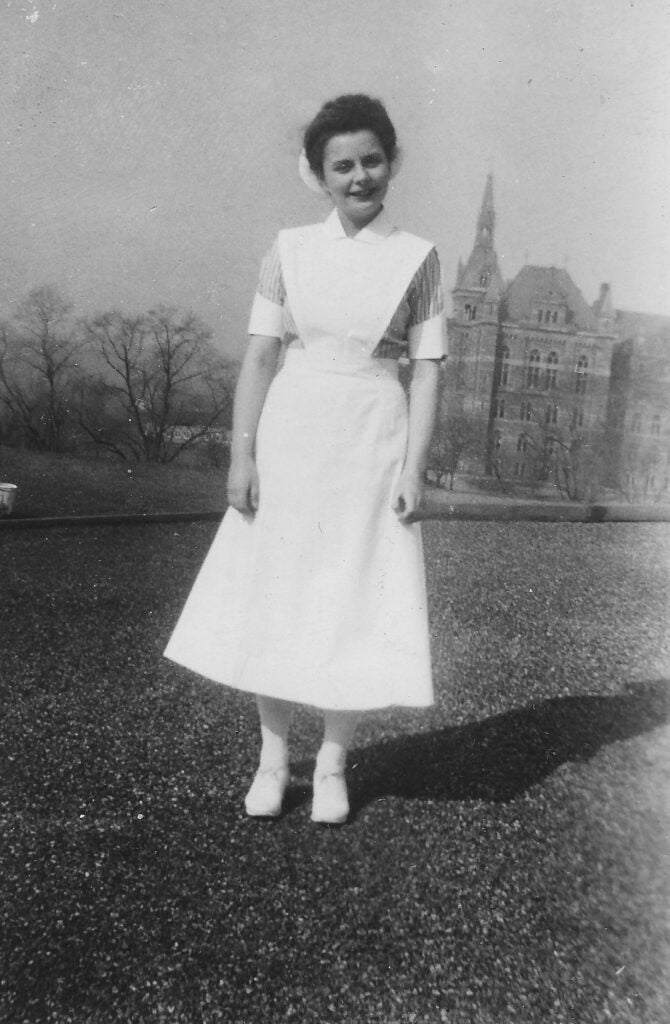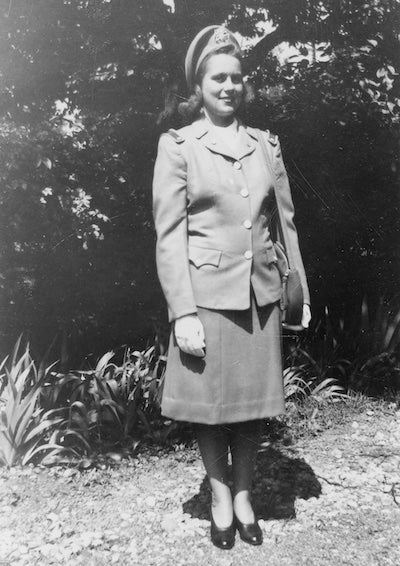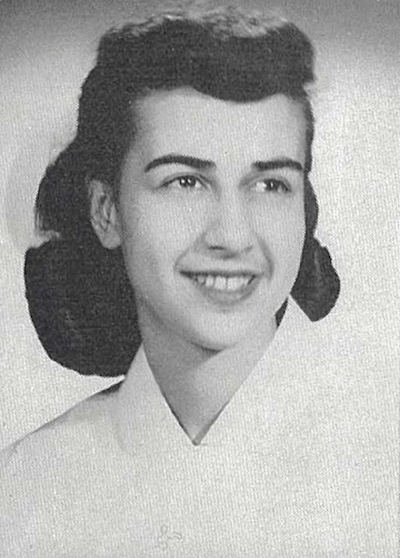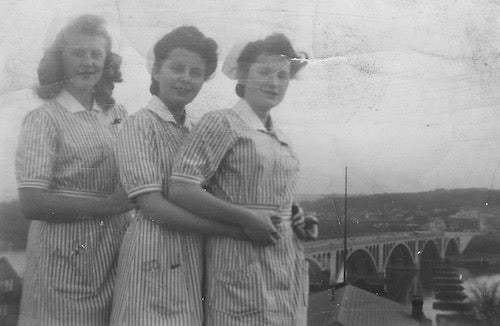Women’s History Month 2021 — Georgetown University and the Cadet Nurse Corps
March 1, 2021 – During the Second World War, Georgetown took part in a national program called the Cadet Nurse Corps, one that sought to augment the nursing workforce for civilian and military positions.
“World War II brought an acute demand for more nurses for both civilian and military service. Nurses who had been desperate for positions now found more than they imagined,” explains nurse historian Dr. Patricia D’Antonio in American Nursing: A History of Knowledge, Authority, and the Meaning of Work (2010).
To help, in 1943, the Cadet Nurse Corps kicked off, according to the author. “Administered by [the] U.S. Public Health Service, the Cadet Nurse Corps effectively recruited women, paid both their educational and living expenses, expedited their training in schools that met accepted standards, and assigned them to essential civilian and military positions ‘for the duration of the present war,’” she writes.
Three GU Nursing Alumnae: Classes of 1945, 1947, and 1948

Mary (Sanker) Candon, who turned 97 in February, graduated with the diploma in 1945. According to daughter MaryEva (L’83), Candon was a head nurse at Georgetown Hospital and went on to receive her BSN, with a focus on psychiatric nursing, in 1981 at Marymount College. She worked in Providence Hospital’s pulmonary health clinic in the 1970s and, beginning in the 1980s, at Sibley Hospital’s psychiatric unit for two decades. She and her husband met at Georgetown during his dental residency, and they had five children, including Georgetown Law alumni MaryEva and Charles (L’84). (In the Cadet Nurse Corps photo above, Candon is standing third from left.)

Marion (Peters) Saunders, also 97, was able to pursue her studies in nursing at Georgetown because of the Cadet Nurse Corps, according to her son Jim, who shared this photograph. “She has always been very proud of having graduated from the program. It provided a path to college when one would not otherwise have been available to her,” he writes. She graduated with the diploma in 1947 and went on to work for a time in nursing before raising her family.

Marie (Santora) Bruce was in the last class to participate in the Cadet Nurse Corps. The program ended with the diploma class that began in 1945, according to Dr. Alma S. Woolley’s Learning, Faith, and Caring: History of the Georgetown University School of Nursing, 1903-2000 (2001). Bruce graduated with the diploma in 1948 and then studied for two more years in the College to receive the bachelor of science in nursing in 1950. Read an alumna spotlight about her.
A 1944-1945 school brochure, housed in the Georgetown Archives, and published university-related histories highlight similar details of the program. Overall, more than 3,000 African American women and 124,000 White women received their nursing education as a part of this federal effort, D’Antonio adds.
Cadets at Georgetown
Campus historians Dr. Robert Emmett Curran and Dr. Alma Woolley supply information about the program’s operation on the university’s campus.

In November 1942, three classmates pose together, likely on the rooftop of the old hospital complex, with the Key Bridge behind them. From left to right are Gertrude “Trudy” (Marshall) Dempsey, Candon, and Mary Joy (Ruddy) Belknap. Candon’s other close friends from the Class of 1945 included Jeanne (Geatz) Printy and Jean (Bailey) Paolucci. The Candons and the Paoluccis have been longtime family friends.
Woolley, who mentions the 1944 College Journal photograph, reports, “In August 1943, 39 of the 96 student nurses at Georgetown were enrolled in the Corps, and in spring 1944, half of the 23 students who were capped at Georgetown became members.” (Also read a 2003 American Journal of Nursing article by Woolley about the Corps.)
And Curran, who includes the photo in his book, notes that the original St. Mary’s Hall on Prospect Street resulted from the university’s participation.
“The school’s involvement in the program precipitated the government’s construction of a new home for the school’s nurses on Prospect Street,” Curran writes. “When the new home was completed in the fall of 1944, the seventy-five nurse cadets, who by that time represented half the student body, were the first to occupy it.”
This building cost, Woolley highlights, nearly $83,000. (Unlike the date in Curran, she says the dorm opened in mid-1945.)
Of note, the original St. Mary’s became Xavier Hall in 1956, Curran and the Georgetown Archives describe, which was the year the current St. Mary’s on Reservoir Road opened. Curran’s 2010 book is entitled A History of Georgetown University: The Quest for Excellence 1889-1964.
By Bill Cessato
The author thanks Lynn Conway, the Georgetown University Archivist, for sharing the digital scan of the Cadet Nurse Corps photograph, as well as MaryEva Candon and Jim Saunders for sharing photos and biographical information. The author is also grateful to Ms. Candon for setting up a FaceTime call so he could say “hello” to Mrs. Candon just a few days after her 97th birthday.
- Tagged
- Nursing History

